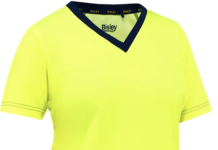Treated fibers are formed with a flame-retardant chemical, which is made into a fabric. Fabrics that use synthetic, or treated, fibers are FR for life the of garment because the flame retardant chemical is resistant to laundering or wear. Specific rules and regulations are applied to testing the durability and how safe each FR fiber is. They must pass or exceed these regulations in order to qualify as FR apparel.
There are many choices when choosing treated fibers and each treated fiber has advantages and disadvantages to using them. We are going to outline the information you need to know to ensure you make an informed decision that is right for your FR apparel needs.
Firewear
Firewear is a blend of 55% Fibrous Flame Retardant Fiber (FFR) and 45% cotton. The cotton provides a great softness to the fabric and is used in polos, t-shirts, sweatshirts and protective hoods. Just as the name implies, Firewear is a great for fire fighter’s work uniforms or for utility workers. However, it is not recommended for use around molten substances or welding operations. Firewear is permanently flame resistant and cannot be degraded. The FFR fiber is spun with a flame retardant in the fiber forming stages. When Firewear is exposed to temperatures about 500 degrees F, noncombustible gases are released to prevent the fabric from burning. These gases have been tested extensively and are safe to the wearer. Firewear will not melt. When wearing Firewear, it is essential for safety that it is not removed in a hazardous area. Caring for Firewear is relatively simple. It should be washed in soft water without chlorine bleach. Using low temperatures will keep the garment from shrinking.
Lenzing FR 100% Rayon
Lenzing FR is a permanently flame retardant, man-made cellulosic fiber. It is typically used in fabric blends and provides moisture absorption without compromising comfort and protection. You will want a garment that uses lending if you need an outer shell fabric for bunker gear or where you will be extremely physical. Lenzing does not provide protection from chemical exposure but does provide good resistance to dry heat and acts an an insulator. It will not melt and is often blended with tenacity fibers to enhance durability and stability of the fabric. When caring for lending there are some options. It can be washed in soft water or if the garment is made of or blended with lending it can be dry cleaned.
Valzon FR
60% Acrylic 40% Cotton. Valzon is comprised of a blend of FR acrylic fiber and cotton. It is recommended for utility workers and for use in fire fighters uniforms. It is not to be used around molten substances or welding environments. Molten substances will melt and destroy the garment. Valzon’s FR properties cannot be degraded through laundering. The FR acrylic fiber is spun with a flame retardant in the fiber forming stages, which therefore will make it resilient to degrading. Valzon is excellent for moisture retention, however it must not be taken off in hazardous areas. When caring for Valzon, follow the manufactures care instructions. It should be washed in soft water at a low temperature. You may use a light soil formula but no chlorine bleach. When drying, use the permanent press setting.
Wool and Rayon Blends – Aluminum Industry Protective Fabrics
Fabrics used in the molten metals, aluminum smelting and casting industries are typically wool and rayon blends. They are designed to shed molten aluminum, cryolite or “bath”, a catalyst used to extract aluminum metal from ore in smelters. Do not wear wool and rayon blended garments in a critical static control environment. Both wool and rayon are relatively stable in hot environments. Wool burns very slowly when in contact with a flame and rayon is very resistant to dry heat and actually acts as a natural insulator. Like most FR fabrics, wool and rayon blended garments need to be washed in soft water. Wash molten splash protective wool and rayon blends separately in buffered surfactant chemistry detergents in a low temperature. Chlorine bleach and perborate both destroy wool fibers, do not use when laundering.




